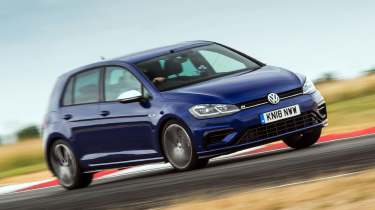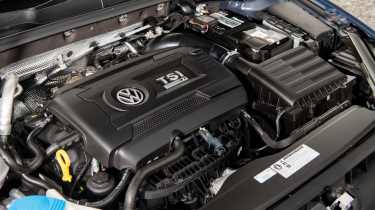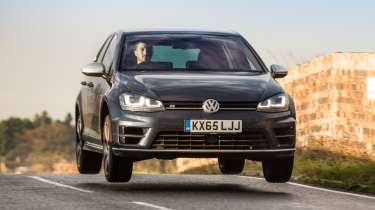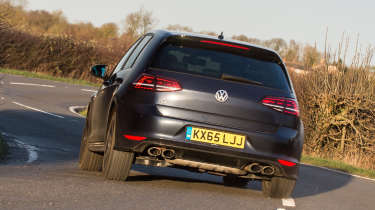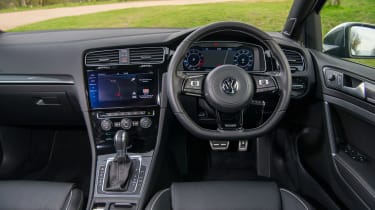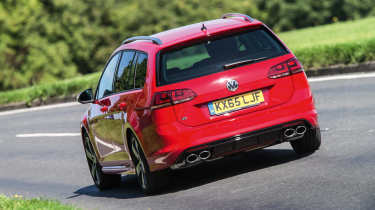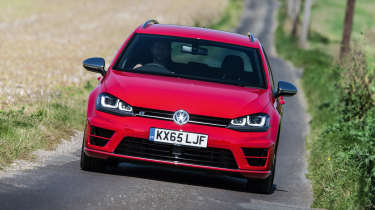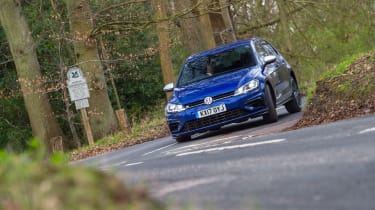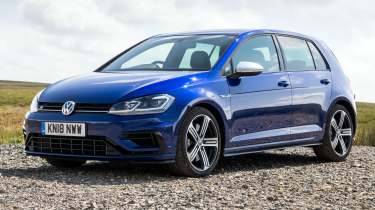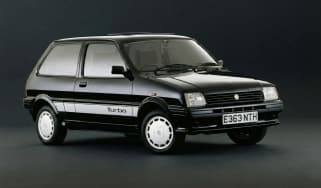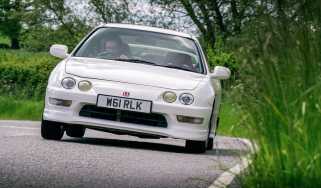Used Volkswagen Golf R (Mk7, 2014 - 2020) review: the original hyper hatch for under £10k
We were always huge fans of the Mk7 VW Golf R. That its successor has never quite lived up to its high standards has only underlined how good it was
The Volkswagen Golf R got off to a rocky start. In its first Mk6 generation outing, it infilled very little dynamic appeal to counterbalance the loss of personality caused by the move from warbling VR6s to a flat turbo four. We found in our extensive testing that the Mk7 Golf R, righted those wrongs in spectacular style, as one of the most dynamically satisfying hot hatches of the 2010s. That its successor has yet to match it cements just what a special hot hatch it is.
Golf Rs are today, and always have been, pricey from new, but with a good few years passed since the last of the Mk7s left showrooms, and over a decade since the first were sold. What is arguably one of the first (and best) in the now prevalent hyper hatch breed, can now be picked up for new supermini money.
> Volkswagen Golf R review – Mk8.5 not the return to form we'd hoped for
Engine, gearbox and technical highlights
This is one of our favourite hot Golfs, delivering fantastic point-to-point speed without the numbness of the technically related Audi S3 of the time. The sheer performance dominates at first: the EA888 turbocharged four-pot delivers massive thrust, peaking at 296bhp with 280lb ft of torque. That’s not far off what you get from today’s Mk8.5 Golf R, and the sprint to 62mph is dispatched in a very respectable 5.1sec.
More reviews
Group tests
In-depth reviews
A Haldex four-wheel-drive system is responsible for delivering that potential to the road, and it does so in pretty much all conditions. This is key to the R’s appeal – it’s so easy to extract its maximum, and it goads you into pushing the envelope to find where the limits are. You’re unlikely to discover them on the road, but there’s a satisfying suppleness and poise to enjoy when you aren’t leaning on it. One area where the Mk7 can’t match its successor is in terms of throttle adjustability on corner exit; while the Haldex system can divert almost 100 per cent of torque to the rear axle, it lacks the Mk8’s torque-vectoring rear differential to help it rotate. The Mk7 instead leans towards stability but in some ways feels more natural to drive.
The first Mk7 Golf R was introduced in 2014, as both a three and a five-door, with the option of both manual and DSQ dual-clutch transmissions. The facelifted ‘Mk7.5’ models arrived in 2017 to sweeten the R with improved tech, and an even sharper design. This Mk7 Golf R goldilocks zone was short-lived, however, with the inception of WLTP emissions regulations in 2018/19 forcing VW to pinch the car’s performance, quieten the already dull sound and drop the six-speed manual transmission option.
To make up for this, later models were able to be optionally equipped with a Performance Pack and an expensive Akrapovič exhaust system, but none reached the heights of those early manual 7s. Just about the rarest Mk7 Golf R you’ll find today is a facelift three-door (rarer, as Golf Rs were popular with young families) manual, which was only on sale for a couple of short years.
Performance, ride and handling
As per the Mk7 Golf, the Golf R was based upon the ubiquitous VW Group MQB modular platform, which also underpinned its closest Group cousins in terms of performance, the Audi S3 and Seat Leon Cupra. It was also the basis for distantly related performance models like the Audi TTS.
With the area of V6-engined Golfs a memory the Mk7 R is, predictably, powered by a four-cylinder turbocharged engine. It’s a heavily ‘breathed on’ development of VW's familiar 'EA888' unit, as has become ubiquitous in hot Golfs over the last few years. The modifications to upgrade it to Golf R spec were pretty substantial and include a new cylinder head, new injectors, a larger turbo and different pistons.
Power is channelled to all four wheels via a six-speed manual gearbox or an optional six-speed DSG double-clutch automatic with steering wheel paddles and VW’s 4Motion system, which featured the fifth generation multi-plate clutch and upgraded suite of electronic aids.
The estate – which was only available with a seven-speed DSG ’box, not as a manual – carries an 80kg weight penalty over the equivalent hatch, but it can also accept much larger loads – 1620 litres with the rear seats folded, versus 1233. Like all Mk7 Golfs the cabin is built to a high standard too – up front at least, the rear plastics are bit scratchy and prone to marking.
The Mk7 Golf R sits 5mm lower than an equivalent GTI (20mm lower than a standard Mk7 Golf) and has firmer springs. The optional adaptive chassis control system – which progressively firms the dampers, sharpens throttle response and reduces steering assistance as you click through the modes – culminates with a more aggressive 'race' setting, chiefly for track days.
It's worth noting that the Golf R's DCC mode was originally controlled using a button next to the gearstick, but that was moved with the facelift to a sub menu within the car's navigation system. The Mk7 R does allow you to fully switch off its stability control system (lesser versions limiting you to a 'Sport' mode).
Interior and tech
For all the value attached to the hot powertrain, the Mk7 R is still a Golf so there’s bags of space for people and chattels. The driving position is spot-on, too, with lots of steering wheel and seat movement, though the transmission tunnel running down the middle of the cabin might inconvenience a middle seat passenger in the back.
Actually, it’s not a great place to be as the R’s sculptured rear sports seats are designed mainly for two. Boot volume is squeezed to accommodate the 4wd hardware but at 343 litres (down from 380) it’s still more than reasonable. And with the seats folded, you get 1233 litres of luggage space, though the R comes with an 18-inch space saver wheel as standard.
Quality and equipment levels were top notch for their day and the Mk7 R still stands up well, as a better nailed-together, more intuitive product than even the Mk8 that succeeded it. It doesn’t have the latest interior tech and that’s no bad thing – praise be to tactile physical buttons over complex touchscreen-based controls.
All versions came with air-conditioning, a Driver Alert system, seven airbags, including a driver's knee bag, five three-point seat belts, ABS with ESP, XDS electronic differential lock and ISOFIX preparation for two rear child seats. There's also an 8-inch touchscreen media system, DAB radio, a CD player, MDI interface (for connecting iPod or MP3 player), Bluetooth telephone preparation and audio streaming and eight speakers. Facelift cars came with a full-width (12.3in) high-resolution display in front of the driver, and the option of the 9.2in Discover Navigation Pro infotainment system with a glossy touchscreen.
Volkswagen Golf R Estate (Mk7)
Mk7 Golf R hatches flew out of showrooms when they were new. The combination of genuine sports car pace, the usability of a normal Golf and some very attractive lease deals made them massively popular, as did the fact that Volkswagen had honed the model’s driving experience to a very high level. Despite packaging the same broad talents in a more practical body, the Golf R estate sold in much smaller numbers, but in some ways it’s even more appealing. Who wouldn’t want to go Cayman hunting in a plain-looking family hauler?
'Just like the hatch, the estate gets better the harder you push it. That initially smooth and supple ride is met with tighter body control, sharper steering and ever the more incisive turn-in and response.
While the estate is a full 80kg heavier than the hatch, little is lost in terms of dynamic abilities. It’s both massively fun yet entirely benign, being so poised under pressure that it’s possible to take the most outrageous liberties with the estate without it ever breaking a sweat.
Steering feel is a step above most of the hot hatch competition, with it easily besting the likes of a Focus ST Estate or an Octavia vRS. It’s crisp and pure, yet gives enough feedback to properly engage you with the R’s darty front end.
Haldex four-wheel drive coupled with an XDS+ torque vectoring system help ensure that the R estate does a very good job of getting its power to the road. The front axle resists push admirably well and by backing the car into a corner on the brakes the rear end can be persuaded to take on some attitude, although it’ll never do so under power alone.
The Golf R Estate uses a turbocharged 2-litre four-cylinder engine which, like most of the current mega-hatch crop, delivers plenty of performance but not that much personality. VW has done a good job disguising some of this via the clever sound symposer, which actually delivers a more convincing engine note than most of the competition. You also get a fantastically over the top ‘brrp’ from the exhaust on upshifts which rattles nicely down the longer estate cabin.
The powertrain does feel strong. It boasts a smooth and linear performance with just the right amount of turbocharged shove yet all the refinement you’d expect in a Golf. When you're cruising it's as quiet as any other Golf, but there's always a hit of power waiting for whenever you need it.'
What we said
evo Car of the Year 2014 verdict
‘Generous in feel and endlessly forgiving, hugely capable yet malleable and accessible, the Golf R nurtures the less experienced and engages the skilled with equal aplomb. Such dynamic depth and dimension is truly special, but when it comes in a package as practical as the Golf, it really grabs your attention. What really sets the R apart is its completeness.
‘From the engine that thrives on revs yet never feels peaky, to sweetly judged steering and brakes and a chassis that blends accuracy and stability with agility and effervescence, you always have the best of both worlds. There’s nothing extrovert or exotic about the Golf, but its deftness is the fairy dust with which all performance cars should be sprinkled.' – Richard Meaden, who tested the Golf R during evo Car of the Year 2014.
VW Golf R Mk7.5 Performance pack
‘It’s a top hot hatch, the Golf R Performance Pack, but it doesn’t really add a great deal to the already towering abilities of the standard R, particularly when you take into account the hefty price premium. The Akrapovic exhaust adds a little more aural drama, but again you have to pay dearly for the limited benefit. So, unless you need the bar-room bragging rights of having the priciest and theoretically fastest Golf, we’d recommend keeping to standard with the R.’ – James Disdale.
What to look out for
The VW Golf R was subject to wide acclaim from both critics and owners. As such, word spread pretty quickly and these cars sold well. That means there are plenty to choose from and deals to be done, so don’t rush into a buy.
A high number of owners can be a sign of patchy maintenance history, and it’s worth checking whether the Mk7 R’s known weak points have been addressed. One of these is the thermostat housing, which can fail with age and start leaking coolant; replacing it at a main dealer can cost over £900. The Haldex four-wheel drive can also give problems if not maintained correctly. It requires a fluid change every three years, and if the filter on the Haldex pump isn’t cleaned at the same time, the unit can fail prematurely. A faulty Haldex system can be identified by a heavy bias of drive towards the front wheels, causing excessive wheelspin during a brisk launch. Check for this on a test drive if possible, and for a record of regular Haldex oil and filter servicing.
Of course, owing to their talents as driver’s cars, most have seen enthusiastic use. They generally stand up well to this but it’s especially important for your chosen example to, A) have good service history, with stamps and supporting receipts, B) to have a good MOT history, and C) to have good life left in its consumables – tyres, brakes and so on.
What to pay
The Mk7 Volkswagen Golf R has been off-sale for over a decade now, which means you can get even a nice example of an early car for less than almost any new car on sale today. Early manuals with decent service history and low-ish (sub-60k) miles can be had for as little as £12k. If you want to entertain examples with six figures on the odometer, then under £10k is possible. Facelifted cars with high miles are about the same as nicer earlier examples, with facelifts with under 60k miles costing over £17k. Used Golf R Estates aren’t as plentiful as hatchback equivalents, so expect to pay an extra £2-3k more for one.
Alternatives to the Mk7 Golf R
The Mk7 R’s main rivals were of the premium persuasion by the end, with the closely related Audi S3, four-wheel drive BMW M135i and Mercedes-AMG A35 all almost perfectly aligned with VW’s effort. The old BMW M140i was a unique competitor to the Mk7 in its earlier years, as a rear-drive hot hatch.
Other front-driven alternatives included the FK8 onda Civic Type R, Renault Megane RS, Ford Focus ST and VW’s own GTI and GTI Clubsport. All were considered to be more entertaining to drive. An AWD alternative for if the Golf R is too boring in almost every way was the mad Ford Focus RS.
Volkswagen Golf R (Mk7) Specs
| VW Golf R (2014) | VW Golf R (2017) | VW Golf R (Performance Pack) | |
|---|---|---|---|
| Engine | In-line 4-cyl, 1984cc, turbo | In-line 4-cyl, 1984cc, turbo | In-line 4-cyl, 1984cc, turbo |
| Gearbox | Six-speed manual or seven-speed DSG | Six-speed manual or Seven-speed DSG | Seven-speed DSG |
| Power | 297bhp @ 5500-6200rpm | 306bhp @ 5500-6500rpm | 306bhp @ 5500-6500rpm |
| Torque | 280lb ft @ 1800-5500rpm | 295lb ft @ 2000-5400rpm | 295lb ft @ 2000-5400rpm |
| Weight | 1476kg (204bhp/ton) | 1499kg (207bhp/ton) | 1501kg (207bhp/ton |
| 0-62mph | 5.1sec (manual) | 5.1sec (manual) | 4.5sec (DSG) |
| Top speed | 155mph | 155mph | 166mph |
| Price new | £29,900 | £32,360 | £37,210 |
| Price now | From £9k | From £15k | From £17k |
